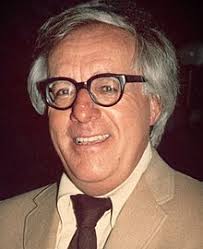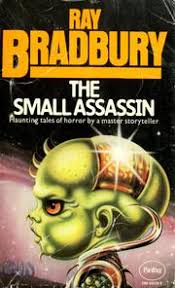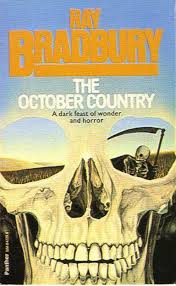
I’ve just realised that today is the 100th anniversary of the birth of the stupendous American writer Ray Bradbury, who died in 2012. So, in recognition of the great man’s centenary, here is a slightly revised version of what I wrote on this blog eight years ago when I heard of his passing.
The death a few days ago of American writer Ray Bradbury drew tributes, to both the man and his remarkable fiction, from everybody from Barack Obama to Stephen King. It seems a bit pointless for the author of a lowly and obscure blog like Blood and Porridge to say more about Bradbury and his oeuvre on top of what’s been said already. But of course, I’m going to say it anyway.
Bradbury I would definitely classify among the top ten writers, and quite possibly among the top five, to have most influenced me – not just as a writer (or an attempted one) but in my whole outlook. Only last weekend, I was having lunch with a colleague and our conversation somehow got around to what our favourite flowers were. Promptly and automatically, I quipped, “Dandelions, because Ray Bradbury wrote a book about them.” This indicates how deeply the venerable author of Dandelion Wine (1957), The October Country (1955), Something Wicked This Way Comes (1962), Fahrenheit 451 (1953), The Illustrated Man (1951), The Small Assassin (1962) and so on had penetrated my psyche.
Unfortunately, in the obituaries written about Bradbury during the week, several things were said that I’d regard as misconceptions. Here are three such misconceptions and my responses to them.
Misconception number 1: Ray Bradbury, science fiction writer…
William Shakespeare featured a ghost in Hamlet and three witches in Macbeth, but that didn’t make him a horror writer. Similarly, Bradbury’s stories contained the odd dystopian future, the odd adventure set on Mars or Venus, and the odd rocket-ship, but that didn’t mean he was a writer of science fiction – certainly not if you define the term using proper ‘science’, because Bradbury plainly didn’t give a hoot about making his settings and plot devices in any way scientifically feasible. His dystopian futures and alien planets might have been fairy kingdoms where he could let his imagination off its leash and his rocket-ships might have been magical spells that transported his characters to those places.
In fact, his supposed science fiction from the 1940s and 1950s has dated far less than that written by his peers, many of whom had engineering or scientific backgrounds and tried to restrict their plots to what the science of the time deemed possible.
Two of his most famous works, Fahrenheit 451 and The Martian Chronicles, are often cited as key works in science fiction literature, and they do have a plethora of sci-fi trimmings, like mind-controlling totalitarian regimes, populations of citizens kept passive by drugs, wall-sized TV screens, space colonies, alien civilisations, robots. But I actually find them among his less interesting works. It’s telling that the most evocative moment for me in The Martian Chronicles comes in the final segment, The Million-Year Picnic, when the human father introduces his family to the Martians by pointing into a canal. Looking down, they see their reflections in the water – an echo of the famous remark by J.G. Ballard, another great writer who got pigeonholed as a practitioner of science fiction, that the only truly alien world is our own one.
I much preferred it when Bradbury threw scientific caution to the wind and just got on with things – never more so than in his short story The Kilimanjaro Device (1965), where the hero travels back in time to prevent Ernest Hemingway from committing suicide. To do this, he employs a time machine that’s actually a truck.

© Panther Books
Misconception number 2: Ray Bradbury, whose sentimental, nostalgic stories recalled his 1920s and 30s boyhood…
There was obviously a lot of sentimentality and nostalgia in Bradbury’s stories, many of which seemed to be set in small mid-western towns with neatly trimmed lawns and white picket fences and porches where people sat in the evenings and courteously hailed their neighbours as they strolled past on the street – and occasionally the tone of these stories threatened to tip over into twee-ness. But it would be unfair to dismiss him as a literary Walt Disney because on closer inspection you’ll find a great deal of darkness lurking around those lawns, picket fences and porches. And incidentally, many of Disney’s cinematic visions contain more darkness than first meets the eye too.
Take, for instance, the small town in Bradbury’s short story The Handler (1947) where the inhabitants mock and belittle the local undertaker – who secretly gets his revenge on them after they die, by burying them in gruesome conditions that match the foibles they had when they were alive. He fills the veins of the town drunkard with alcohol rather than embalming fluid and stuffs the corpses of a couple of inveterate chatterboxes into the same coffin. Or the fate of the nagging wife in another short story, The Jar (1947), who is not amused when her simple-minded farmer husband buys the titular vessel at a carnival because it has something strange and indescribable and yet fascinating floating inside it. The husband eventually snaps at her nagging and what ends up floating inside the jar at the story’s close is not what was inside it at the beginning. Even Bradbury’s rosiest evocation of his childhood, Dandelion Wine, contains a serial killer among its pages.
Perhaps the darkness in many of Bradbury’s stories eludes readers because he imbues his characters, even the very worst ones, with an ordinariness and even innocence. They’re not the twisted psychopaths that stalk the pages of modern horror fiction. Rather, they’re believably everyday characters who, somewhere along the line, often through gullibility or unfortunate circumstances, take the wrong turn, with grisly consequences. Yet the innocence of those characters serves only to make the stories more disturbing.

© Panther Books
Misconception number 3: Ray Bradbury, with his unique writing style…
And yes, Bradbury was a stylist, but it does him an injustice to imply that that was all there was to his writing. In fact, his stories would have counted for nothing if there hadn’t been ideas, brilliant ideas, propelling them along while his prose-style brought them vividly to life.
In fact, his work contains hundreds of lovely notions and sparks and fancies. For example, there’s the short story A Season of Calm Weather (1957), where Pablo Picasso takes a walk along a beach in southern France, then stops and uses a stick to spontaneously draw a masterpiece in the sand – much to the delight of an art-lover who watches the creation of this masterpiece from a distance. However, the art-lover’s delight turns to agony after Picasso walks away again and the tide starts to creep in… Or there’s the vignette The Foghorn (1951), where the baleful horn sounding from a lighthouse gets answered by a roar out in the mist, which proves to be a last surviving dinosaur mistaking the horn for a mating call. Or the short story The Wonderful Ice Cream Suit (1958), where a group of poor Mexican lads of similar build and height pool their money and buy an expensive white suit that they believe will improve their chances with the ladies. Then, however, they have to figure out how they’re going to share the suit and keep it clean…
Even reading those stories when I was 13 or 14, an age when I was trying my hand at writing myself, I found myself subconsciously cursing Bradbury. I knew these were all wonderful story ideas but the old bugger had thought of them first.
At the time of his passing Bradbury was 91, so he certainly enjoyed a good innings. Mind you, he’d lived for so long and his fans had become so used to him being around that I’d begun to wonder if he was like a character in one of his stories – someone with so much imagination, exuberance and enthusiasm for life that he’d managed to transcend such things as ageing, mortality and death. I had a notion that he’d be around forever, kept going by the joie de vivre that was so apparent in his fiction. But life, alas, is never as magical as it is in a Ray Bradbury story.

© Panther Books
